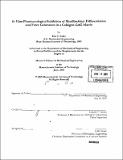In vitro pharmacological inhibition of myofibroblast differentiation and force generation in a collagen-GAG matrix
Author(s)
Soller, Eric C
DownloadFull printable version (3.923Mb)
Other Contributors
Massachusetts Institute of Technology. Dept. of Mechanical Engineering.
Advisor
Ioannis V. Yannas.
Terms of use
Metadata
Show full item recordAbstract
Induced regeneration studies from three organs in the adult mammal (skin, peripheral nerves, and the conjunctiva) suggest an antagonistic relationship between myofibroblast-mediated contraction of wounds and induced regeneration. In each instance of induced regeneration, contraction blocking was accomplished using regeneration templates, or scaffolds of highly specific structural and chemical properties that mainly control the environment or the density of contractile cells (myofibroblasts). In addition to scaffolds, diffusible factors could be used to inhibit specific components of the intracellular pathway in an effort to further evaluate the relationship between contraction and induced regeneration. The crucial role that Rho- associated coiled-coil forming protein serine/threonine kinase (ROCK) seems to play in cell-mediated contraction and cytoskeletal remodeling behavior of fibroblasts make it an attractive target for pharmacological inhibition. A preliminary in vitro study was conducted to evaluate the effect of Y-27632, a specific pharmacological inhibitor of ROCK, on the contraction of highly porous, three-dimensional type I collagen- glycosaminoglycan (CG) matrices over time by attached NR6WT fibroblasts treated with TGF-[beta]1, a known upregulator of both fibroblast contraction and expression of the contractile filament [alpha]-smooth muscle actin ([alpha]-SMA), a hallmark of the myofibroblast phenotype. NR6WT fibroblasts were seeded into free-floating cylindrical CG matrices (8 mm in diameter, n=6) and treated with serum-containing media supplemented with TGF-[beta]1 (3 ng/ml) or both TGF-[beta]1 (3 ng/ml) and Y--27632 (10 [mu]M) for 12 days. (cont.) Control cells (untreated) were cultured as well as unseeded matrix controls. The diameter reduction of matrices was determined daily by visual comparison to circles of known diameter (...). Contraction was calculated as the change in matrix diameter from the day 0 value divided by the day 0 diameter and is a measure of radial strain in the substrate. Cell-mediated contraction (CMC) was determined by subtracting the contraction of the unseeded matrices from the contraction of the seeded matrices. The average number of attached fibroblasts per matrix for each experimental group was determined at the end of the 12 day contraction experiment. At a dosage of 10 [mu]M, Y-27632 significantly attenuated TGF-[beta]1-stimulated cell-mediated contraction of free-floating CG matrices by NR6WT fibroblasts. While Y-27632 treatment also decreased the cellular content of the matrices compared to control cells, the relative magnitudes of cell-mediated contraction (C(MC) normalized o the attached number of fibroblasts indicate a statistically significant difference between mean values for TGF-[beta]1 treated cells and cells treated with both TGF-[beta]1 and Y-27632 (p<0.001). The data suggest that cellular de-adhesion alone does not account for the inhibitory effect of Y-27632 on TGF-[beta]1 stimulated cell-mediated contraction of CG matrices. A likely explanation is that the inhibitor is blocking the ability of fibroblasts to express an agonist-induced contractile phenotype and instead encouraging the development of a more migratory one. (cont.) The observed effect of the inhibitor on contraction could have been through inhibition of the contractile filament [alpha]-SMA, although expression of this protein was not assayed in this study. The demonstrated ability of Y-27632 to inhibit TGF-[beta]l1-stimulated force generation support its use in a future in vivo study that would evaluate the relationship between contraction blocking using pharmacological inhibitors and induced regeneration in a peripheral nerve wound model.
Description
Thesis (S.M.)--Massachusetts Institute of Technology, Dept. of Mechanical Engineering, 2005. Includes bibliographical references (leaves 35-39).
Date issued
2005Department
Massachusetts Institute of Technology. Department of Mechanical EngineeringPublisher
Massachusetts Institute of Technology
Keywords
Mechanical Engineering.